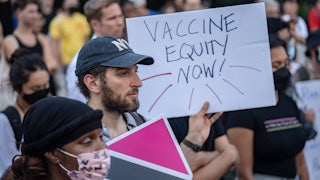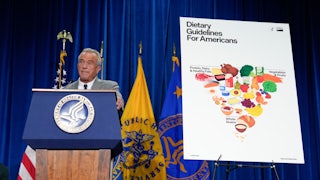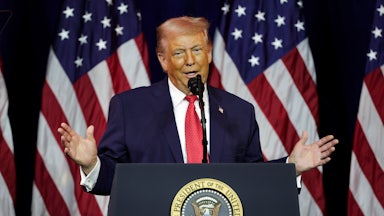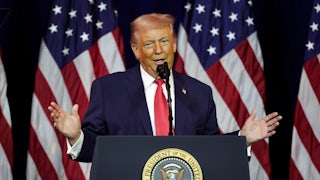Monkeypox cases, after a precipitous rise since June, are finally falling in the United States. Counterintuitively, this is exactly the moment, public health experts say, when testing should ramp up. The U.S. may have a chance to stamp this virus out, or at least confine it to the smallest possible number of continuing cases. But that window will close quickly.
Case counts dropping is a good thing. But cases are only determined by testing, which until now has focused on a very narrow section of the population. That means that unless we expand testing, it’s impossible to tell whether these falling case numbers represent a real and sustained drop or whether they signify that the virus is moving into other unrecognized groups.
Even if this drop continues, we now know that monkeypox could be with us for a long time, which means the U.S. needs a better testing infrastructure to head off outbreaks like the record-breaking one we saw this year; clinicians and patients need to be aware of the risk factors for monkeypox and the subtle ways the disease can show up, and lab capacity needs to stay strong. We also need to monitor animals to see if the virus has spilled over into animal populations in the U.S., which could lead to future outbreaks.
“We need to have our antennae up and be thinking about it at all times,” Dr. Ida Bergstrom, an internal medicine physician in Washington, D.C., told me. “And just test even if you think it’s low risk, because until we really are more aggressive with who we’re testing, we won’t have a firm handle on where this disease is.”
That also means tracing cases closely, especially in homeless shelters, prisons, nursing homes, daycares, and schools, and especially anyone who contracts monkeypox with no known links to other monkeypox patients. Tried-and-true outbreak response, like contact tracing, is the only way to strengthen our understanding of how monkeypox spreads and what practices—including support for quarantine and isolation—will stop it.
While vaccines and antivirals may also help stem transmission—by making someone contagious for a shorter period of time, for instance—the extent to which they help drive down cases isn’t clear yet. The gains the U.S. has made likely came in large part because of behavior change, which won’t last forever.
“The biggest concern, actually, is that the decrease is not going to be sustained because behavior change is not often sustained indefinitely,” Dr. Abraar Karan, an infectious diseases physician at Stanford University, told me. “It’s something that’s happening for the time being, but most of the time people will revert to their prior sexual practices at some point.”
This dip gives us a fleeting opportunity—if not to eradicate the virus entirely in the next few years, then at least to keep cases so low that monkeypox is no longer a pressing threat. But that means we can’t let up on the response right now—instead, we need to accelerate even more.
Testing can tell you who is getting sick and, perhaps as importantly, who is not getting sick, so we know exactly where to send resources. During the early days of an outbreak, if testing capacity is limited, only those with the strongest suspicion of illness usually get tests. In this case, monkeypox testing was almost exclusively confined to men who have sex with men and who showed classic monkeypox symptoms. “It’s the risk factors plus the rash appearance,” said Dr. Glenn Wortmann, an infectious diseases specialist at MedStar Health in Washington, D.C.
But in every outbreak, the sooner capacity can expand beyond the group thought to be at highest risk, the better. “If you’re only testing that group, you’ll never know where else it is,” Bergstrom said. “It’s like Trump saying, ‘Let’s not test because then we won’t find Covid.’ Well, that’s certainly true. ‘Let’s not test it, so then we won’t know if it’s anywhere else’—that’s the problem.”
Even now, many providers will only test patients if they belong to a high-risk group—if they are men who have sex with men or if they frequently engage in sex with multiple partners, like sex workers.
“If the provider says, ‘That could be monkeypox,’ it’s easy enough to just take a swab and test for it,” said Wortmann. But they usually only do so if there’s “clinical suspicion”—if the doctor thinks it’s likely. “If you, willy-nilly, test everybody that walks in the room, you’re going to have some false positive tests,” Wortmann said.
But expanding those guidelines to anyone who has symptoms could lead to some surprises.
“Anytime you have an outbreak like this, expanding the criteria to get testing tells you a lot, because you’ll then discover people that are positive who you maybe wouldn’t have expected to be, or you’ll have a better sense of who is turning positive and who isn’t,” said Karan. “Lowering the barrier to test is really important.”
Cases are still predominantly being found in men who have sex with men (often abbreviated as MSM). The vast majority—92 percent—of cases are among MSM who had recent sexual contact, according to a Lancet study in Spain. But expanding testing to other groups would make sure that the decline—and the predominance among MSM—is not ascertainment bias.
Even as cases overall fall, the share of monkeypox cases is growing in non-MSM populations. In recent weeks, 20 percent of cases in the U.S. have been in men who report no sexual contact with other men. Women and people of other genders are also seeing a higher share of cases, and there are about 50 cases of monkeypox among children in the U.S.
“It’s increasing slower than we saw the transmission increase with the MSM population,” Amanda Joy, a physician assistant with MedStar Health, told me last month. “But we all know it’s only really a matter of time for it to grow outside of that population. Regardless of the population, we don’t want it to grow at all.”
This doesn’t necessarily mean monkeypox is suddenly moving into new populations. Another option is that we could simply be getting better at identifying the cases already in these groups, Dr. Caitlin Rivers, a senior scholar at the Johns Hopkins Center for Health Security, told me. And a third reason might have to do more with human nature than virology: Some of these cases may actually be from sexual contact, but they’re not being reported as such.
That’s something providers need to keep in mind—that not all patients are able or willing to disclose their potential risk factors. “If a patient comes in and says, ‘I want you to test me for monkeypox,’ I mean, absolutely, I’ll test you for monkeypox,” Bergstrom said. “Because number one, it’s no skin off my back. But number two, there are things that patient knows that maybe they haven’t told me.… You don’t know if they have some risk factor that they don’t feel comfortable telling you.”
Another indication that we’re still not testing widely enough has to do with a phrase popularized by the Covid pandemic: test positivity. More than one in four monkeypox tests are currently coming back from the lab positive. That’s too high, Rivers said, even for a disease that has some pretty distinctive symptoms that make it easier than others to diagnose: With monkeypox test positivity, “something like 10 percent feels right.”
It’s possible that test positivity is high because clinicians are so good at knowing when symptoms are likely to be monkeypox, and only testing then—but at this stage in the outbreak, with only a few months of experience making such diagnoses in countries where monkeypox has never spread like this before, it’s very likely that some cases are slipping under the radar, Rivers said. “I think it’s worth testing broadly and trying to get that test positivity down.”
The U.S. has not released information on test positivity among different parts of the population, but collecting and releasing that data could be helpful. “Data on test positivity by demographic group,” Rivers said, “would help us to have confidence that, for example, there are not a lot of missing cases in women because all of the tests are coming back negative.” That would indicate that monkeypox spread probably is confined to the groups already identified as high risk.
In cases where someone outside of the main risk group contracts the virus, studying their experience is key for understanding how and when the virus spreads. Karan recently co-authored a study about a case in a traveler with no known contact with monkeypox patients and no recent sexual exposure. “What was interesting about it was the fact that he didn’t have sexual contact and then also, on exam, he didn’t have ano-genital findings. So how does route of transmission play into the clinical and physical manifestations of the disease?”
The issue with testing doesn’t seem to be laboratory capacity. Now that commercial labs are processing monkeypox tests, the U.S. is only using about 10 percent of its available testing capacity. It’s also quite easy to do the tests, Bergstrom said. Doctors should already have the swabs that they use for other tests, and they’re very easy to transport.
Instead, the holdup seems to be happening long before the lab receives the sample: in patients and health providers who just haven’t been considering monkeypox as a possibility and testing for it.
“In the beginning, we were really looking for that prodrome—did they have the fever and the lymph nodes that were swollen, and the high-risk contacts or travel?” Joy said. Health providers were surprised when they would run a test just in case—on a rash, for instance, or something that looked in the early stages like a zit or a typically harmless virus called molluscum contagiosum—and it came back positive.
“You see these horrific pictures online of all these [monkeypox] pustules everywhere. But we’re seeing more isolated lesions,” Joy said. “It’s easy for providers to miss it, quite frankly, or mistake it for something else.” Patients who previously came in thinking they might have herpes or hemorrhoids, or just a rash, had to shift gears quickly as well. The MSM community rapidly learned about the risks and early symptoms, and how to curtail spread.
One of the problems with testing now is that nearly all labs in the U.S. look at swabs from lesions or rashes. But, especially in the early course of the illness, patients might not have visible symptoms. And Karan suspects that the virus has been spreading from those with mild or no symptoms yet. “I would say that it’s happening enough that we had sustained transmission of this outbreak that we’ve not seen before,” he said. “But we don’t know with what frequency or how often that’s happening.”
That means we need to create new tests, including saliva tests and rapid at-home tests, Karan said. “If you have a lateral flow test, a test for someone to do this at home, then they can regularly with some frequency be testing—especially if they’re a high-risk person or in high-risk sexual networks—such that onward spread would be minimized.”
Another emergency right now is vaccine and testing equity. So far in the U.S., Black and Hispanic people have been disproportionately affected by monkeypox—with disparities that are increasing over time—yet they are receiving a lower share of vaccines. The inequities are even worse globally. Not a single vaccine has been given in any African countries where monkeypox has been endemic for decades, and test kits have been in short supply in these countries. This isn’t just an urgent moral problem. It’s also shortsighted: Inequity will result in continued cases around the world, including in the U.S., and make it harder to curtail the virus.
Elimination in many places is a real possibility. If animal surveillance—which must also be expanded—shows that the virus is circulating only in humans in the countries experiencing new outbreaks, “then this disease is in theory a candidate for elimination,” Rivers said. “I think that that’s still on the table. I don’t think the window has closed.” And even if the virus isn’t eliminated entirely, pushing cases as low as possible would be a huge public health win.
The worst thing we could do now is to see cases are falling and believe the problem is going away. With Covid, for instance, we breathe a sigh of relief every time a surge peaks and then falls. But often, there are more people infected—and more people dying—on the long downslope of a drawn-out epidemic as the virus continues spreading. The downward trend is seductive, tempting us to tell ourselves we’re out of the woods now and we can ease up on our response. But thinking we are done with monkeypox is the surest way for the virus to remain a serious threat.










